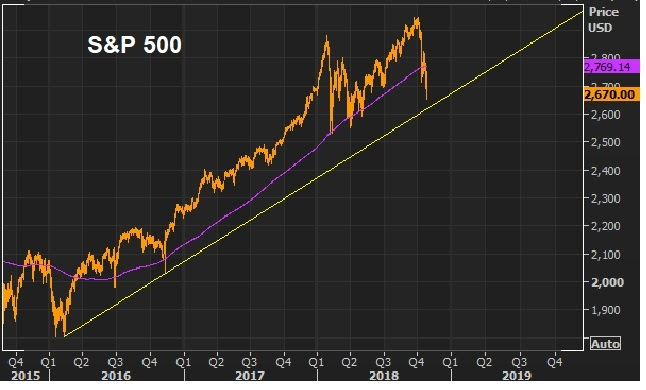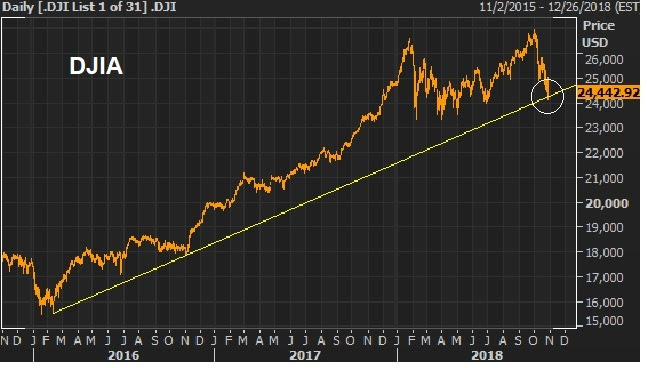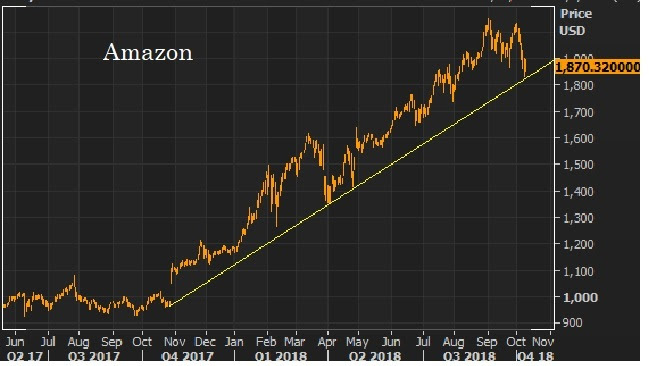|
|
|
October 25, 5:00 pm EST Yesterday we looked at this big trendline support in stocks (the yellow line).
|
 |
|
We had a good bounce today, but experience tells me that we will make a run at that trendline, and things will look a little messy before we bottom. We still have seven trading days before the mid-term elections. A stock market in correction is not as easy to promote as one at record highs (as we had just earlier this month). With that, I suspect there are plenty of interests (China among them) to keep the pressure on stocks in hopes of dividing U.S. Congress come November 6th. When the dust clears from the elections, market folks will realize that stocks are incredibly cheap at 15 times next year’s earnings estimates, in an economy growing better than 3%. On that note, we have our first look at third quarter GDP tomorrow. The market is looking for 3.6% growth, which would give us 3.22% annualized growth averaged over the past four quarters. That would be the best growth since 2006. If you need help with your shopping list of stocks to buy on this dip, join me in my Billionaire’s Portfolio. We follow the world’s bests billionaire investors into their favorite stocks. Click here to learn more. |
October 23, 5:00 pm EST
As we discussed yesterday, despite all of the drama about China, Italy,
Brexit, rates and the elections, what seems more likely to have driven the recent correction in stocks is Saudi selling.
In fact, I think it’s clear that there has been a Saudi liquidation (of U.S. and global assets) which was the catalyst for the correction in stocks earlier this year, and this recent decline.
Remember, in November of last year, the Saudi Crown Prince Salam, successor to the King, ordered the arrest of many of the most powerful Saudi Princes, country ministers and business people in Saudi Arabia on corruption charges. Over $100 billion in assets were claimed to be under investigation (a third frozen) in what was called the “Saudi purge.”
These subjects were detained for nearly three months. The timing of their release and the market correction of early this year is where it all begins to align.
They were released on Saturday, January 27. S&P futures open for trading on Sunday night. Stocks topped that night and proceeded to drop 12% in six days. And rallies in stocks were sold aggressively for the better part of the next seven months.
Fast forward to this month, and we have the murder of the journalist that was a public critic of the Crown Prince Salam. As the details of story pointed back to Salam, on Oct 3, U.S. bond markets got hit (to the hour of news hitting the wires) and stocks topped that day, and have proceeded to drop by more than 8%.
Clearly, the destabilization in Saudi Arabia has put considerable assets in jeopardy. With that, those in control of those assets have likely been scrambling to protect them, as U.S. Congress pushes for sanctions, which could include freezing Saudi assets.
Since stocks dipped last week, I’ve heard the chatter (again) about how a 3% 10-year note has suddenly created a high appetite for Treasurys over stocks (i.e. people are selling stocks in favor of capturing that whopping 3% yield).
But in this post-crisis environment, a rise toward 3% promotes the exact opposite behavior. If you are willing to lend for 10-years locked in at a paltry rate, you are forgoing what is almost certainly going to be a higher rate decade than the past decade. If you need to exit, you’re going to find the price of your bonds (very likely) dramatically lower down the road.
Coming out of a zero-interest rate world, bond prices are going lower/not higher. Here’s the chart of the 10-year Treasury note (price). You can see we’ve now broken the three and a half decade bull market in bonds (yields go up, as bond prices go down) …

stocks
Bottom line: The bond market is the high risk-low reward investment in this environment. And there continues to be plenty of fuel for stock prices as money exits bonds.
|
October 12, 5:00 pm EST
The S&P 500 has declined more than 5% (from peak to trough) on four different occasions this year. That’s despite an economy that is heating up, finally escaping the slow growth rut of the past decade.
So, should you be fearful when these declines occur, or should you be greedy?
During market declines – with the constant barrage of market analysis and opinion on financial television, in newspapers, or through the Internet – it’s easy to get sucked into drama played out in the media.
And that tends to make many investors fearful.
But while the fearful start running out of the store when stocks go on sale, the best billionaire investors in the world, start running IN.
The fact is, the best investors in the world see declines in the U.S. stock market as an exciting opportunity. And so should you.
Most average investors in stocks are NOT leveraged. And with that, they should have no concern about U.S. stock market declines, other than saying to themselves, “what a gift,” and asking themselves these questions: “Do I have cash I can put to work at these cheaper prices? And, where should I put that cash to work?”
Billionaire Ray Dalio, the founder of the biggest hedge fund in the world, has said what we think is the most simple yet important fact ever said about investing.
“There are few sure things in investing … that betas rise over time relative to cash is one of them.”
In plain English, he’s saying that major asset classes, over time, will rise (stocks, bonds, real estate). The value of these core assets will grow faster than the value of cash.
That comes with one simple assumption. The world, over time, will improve, will grow and will be a better and more efficient place to live than it was before. If that assumption turned out to be wrong, we have a lot more to worry about than the value of our stock portfolio.
With that said, as an average investor that is not leveraged, dips in stocks (particularly U.S. stocks – the largest economy in the world, with the deepest financial markets) should be bought, because in the simplest terms, over time, the broad stock market has an upward sloping trajectory.
This is the very simple philosophy Dalio follows, and is the core of how he makes money and how he has become one of the best, and richest, investors alive.
Billionaires Bill Ackman and Carl Icahn, two of the great activist investors, lick their chops when broad markets sell off on fear and uncertainty.
Ackman says he gets to buy stakes in high quality businesses at a discount when broad markets decline for non-fundamental reasons. Icahn says he hopes a stock he owns goes lower so he can buy more.
What about the great Warren Buffett? What does he think about market declines? He has famously attributed his long-term investing success to “being greedy when others are fearful.”
Bottom line: Declines in the broad market are times to take out your shopping list.
If you need help with your shopping list, join me in my Billionaire’s Portfolio. We follow the world’s bests billionaire investors into their favorite stocks. Click here to learn more.
October 11, 5:00 pm EST
|
Yesterday we talked about the repricing of the tech giants as the catalyst for the slide in global stocks. That slide continued today.
But the brunt of the punishment is back on the Dow, which was down another 2%. At the lows today, that takes us back to flat on the year for the DJIA … up 1% for the S&P 500. And the Nasdaq, at the lows today, was up just 4.8% on the year. As they say, stocks go up in an escalator and down in an elevator. Interestingly, in this slippery slide for stocks, money has NOT been piling into bonds. This is the flight to safety trade we’ve seen throughout the post-financial crisis era. It doesn’t seem to be happening this time. The 10-year yield remains in sniffing distance of 3.25% (closing today at 3.14%). So, where is the money going? Gold. Gold is on the move — the top performer in global markets today. And it looks like it’s just getting started. As I said last week, “the set up for a bounce in gold here looks ripe. The level to watch will be 1,214.” |
 |
|
You can see in the chart, the 1214 level gave way today, and we had a break of the downtrend of the past six months. Now, when we discussed gold last week, we were talking about the potential for China to perhaps try a few shenanigans over the next month, in order to influence the outcome of the November elections. Here’s an excerpt from that October 3rd note: “China remains the holdout on making a deal with Trump on trade. And it looks likely that they are holding out to see what the November elections look like.
Will Trump retain a Republican led Congress? I suspect we may see China do what it can to influence that outcome. As we know, the Republicans will be promoting the economy as we get closer to voting day. What can China do to rock that boat? They can sell Treasuries, in an attempt to ignite a sharper climb in rates. And a fast move in rates (at these levels) has a way of shaking confidence in equity markets–which has a way of shaking confidence in the economy.“ I suspect we may be seeing precisely this above scenario play out. If you haven’t joined my Billionaire’s Portfolio, where I hand select a 20-stock portfolio of the best billionaire owned and influenced stocks, you can join me here.
|
|
|
October 9, 5:00 pm EST There are always plenty of risks surrounding markets. Still, stocks tend to be pretty good at “climbing the wall of worry.”
But we’ve now had some swings since the beginning of the month. Have stocks hit the wall at the recent record highs? Have the growing geopolitical risks begun to finally outweigh the fundamental strength in the economy and the stock market? Not likely. More likely, these risks have served as a catalyst for a correction. In this case, a correction in tech stocks. And it has been driven by one of the highest flyers: Amazon. At the highs of last month, Amazon had jumped 112% in a little less than 12 months. That’s over $500 billion in market cap gains for Amazon since September of last year. Just that increase in valuation alone is bigger than all but four stocks in the world. So, as we’ve been discussing in this daily note for quite some time, the regulatory screws have been tightening on big tech. And Amazon is in the crosshairs. Meanwhile, it has been priced as if the developing monopoly would go unchecked. As I’ve said, “not a good bet.” Now that “monopoly premium” seems to finally be deflating. After crossing the trillion-dollar valuation threshold (which was the dead top in the stock), Amazon has now had an official 10% correction. |
 |
| This big trendline in Amazon will be key to watch.
If you haven’t joined my Billionaire’s Portfolio, where I hand select a 20-stock portfolio of the best billionaire owned and influenced stocks, you can join me here. |











